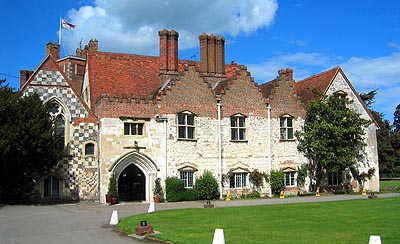
RBH Home
Maps & Travels
Articles
Legends
Towns & Villages
Castles & Houses
Churches
Biographies
Gentry
Family History
Odds & Ends
Mail David
 Bisham Abbey
Bisham AbbeyBisham, Berkshire
Since the Dissolution of the Monasteries, the manor house of Bisham as been known as Bisham Abbey. The abbey itself - which was actually a priory for most of its life - stood alongside and must have dominated the estate in its day. The building we now refer to as the Abbey was not even part of the monastic buildings like so many Tudor mansions which succeeded the redundant enclaves. Here, the manor house is based around an ancient preceptory built by the Knights Templar who owned the manor in the 13th century. The magnificent hall therefore dates from about 1260! There was a separate chapel somewhere nearby which predated the foundation of the abbey. The order was suppressed in 1307 and Edward II seized the place. He used it as a luxurious gaol for imprisoned dignitaries. Queen Elizabeth of the Scots, wife of King Robert the Bruce, was here in 1310, along with her step-daughter Princess Marjorie and sister-in-law, Lady Christine of Carrick.
In 1335, Bisham was granted to the Barons Montacute who eventually became Earls of Salisbury. They founded the priory and the house became their main residence for about two hundred years. The elegant private apartments to the east of the old hall were probably added by William Montacute, 2nd Earl of Salisbury in the later 14th century. They include the council chamber, fine cellar and the so-called 'cloister' - an arcade which apparently formed one side of a graceful quadrangle, since demolished. During this period, the building was, no doubt, the scene of much political intrigue as well as state occasions, especially during the ownership of Richard Neville, the Kingmaking Earl of Salisbury & Warwick. King Richard III was his son-in-law. The Earl's grandaughter, Margaret, last Countess of Salisbury, lived there in the 1520s and 30s, when the dovecote was built.
The great Hoby family took up residence in the early 16th century. From around 1557, Sir Philip Hoby erected the great dining hall and the suite of rooms to the north-west of the old hall. He was the one who reduced the Montacute quadrangle and added the fine bay window to its northern end. The imposing brick tower was added by his brother in 1560. Though not obvious, it has a rather odd plan. The heraldic glass still extant today appears to be referred to in the man's diary (1562): "This year.....the gallery [was] made with noble men's arms, etc." Queen Elizabeth I spent a number of her years of imprisonment here during Bloody Mary's reign and, later, returned to visit Lady Hoby under happier circumstances. The latter owner has left the most enduring of legacies to the house: for her ghost still walks its corridors!
Bisham Abbey is one of the UK's
National Sports
Centres. It is relatively accessible, but not open
to the public.
